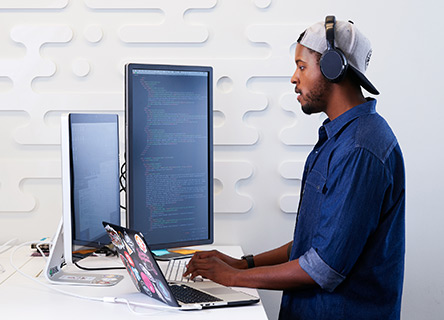Artificial Intelligence
Artificial Intelligence to help in the fight against diabetes
January 22, 2020
Categorized: Artificial Intelligence
Share this post:
Jessica Ball’s life changed in March.
The 33-year-old, from Hervey Bay in Queensland, has been living with diabetes for 12 years. Balancing her blood glucose levels as a busy mother with three young children is a continuous struggle. Some days, she takes about four insulin injections; other days, she may need up to eight to keep her levels in range. All the while, she does finger-prick checks to track her blood glucose.
Five months ago, she started continuous glucose monitoring (CGM). CGM is a way of measuring glucose levels that helps gain insights into patterns and trends of a person’s glucose levels. It requires a disposable sensor, which is inserted under the skin, that can trigger an alert sent to the user’s phone that warns when glucose levels are or are about to be, too low. This is known as hypoglycaemia.
180 extra decisions every day
A 2014 study by Stanford University in California, which was published in Diabetes Care, found that people living with Type 1 diabetes make an extra 180 decisions every day, on average.
According to Diabetes Australia, Type 1 diabetes is most commonly diagnosed in children and young people and makes up about 10-15 per cent of all cases of diabetes. It’s an auto-immune condition in which the immune system destroys the cells in the pancreas that produce insulin, which regulates blood glucose.
If managed well, people with diabetes can live a normal life. If their glucose levels get too low, however, hypoglycaemia can be acute and debilitating with symptoms that can range from dizziness and weakness to blackouts or even death if left untreated. In order to keep glucose levels at a safe level, people with Type 1 diabetes have to carefully consider every snack, every meal, every exertion and every insulin injection – no matter what else they’re doing.
For Ball, hypoglycaemia (or “hypos”) are “pretty much a daily thing” and that the difference between good management and hypoglycaemia is “a really fine line”. That’s why CGM is making such a big difference.
“It’s awesome because it takes away so many of those decisions,” she says. “It alerts my phone if I need to do something with my levels. It’s an absolute life-changer, it takes away some of that stress.”
Her alerts are set up to go to her husband’s phone as well. He texts her when he gets an alert to ask if she’s OK. They have agreed that if she doesn’t respond within a certain time, he will know to come and help.
‘Holy Grail’ for people with Type 1 diabetes
According to Associate Professor Neale Cohen, a consultant physician in diabetes and endocrinology at the Baker Heart and Diabetes Institute in Melbourne, joining CGM and insulin pumps together is the “holy grail” for patients because it means a person’s glucose levels can be “automatically adjusted” on a five-minute basis.
He says advances in technology mean some people with Type 1 diabetes are starting to use CGM instead of traditional finger-prick checks. Some are also starting to use insulin pumps instead of traditional injections to deliver insulin.
“The most exciting thing in the Type 1 diabetes space is an ‘artificial pancreas’. We’ve had insulin pumps and continuous glucose monitoring for a little while, so it’s marrying those things together to get a closed loop. People with Type 1 can have very erratic levels,” he says.
Cohen says the passive nature of this process can make a huge difference to both the physical and mental health of a person living with diabetes. However, there is still work to be done in the field. One avenue that is beginning to attract the attention of clinicians is the role artificial intelligence (AI) can play in identifying patterns and trends that may help predict if someone is about to have hypoglycaemia.
“AI comes into the management of blood glucose in many ways because it’s so complex and so variable. Patients do their best [to manage their levels] on any particular day but there are always all sorts of different things going on in the background that require their attention,” Cohen explains.
“We’re yet to be convinced that these predictive algorithms work 100 per cent of the time. They’re based on a lot of theory, but whether they actually work is still to be seen. Of course, it’s better to have a device that prevents [hypoglycaemia] because it’s automatically adjusting levels on a five-minute basis. Potentially, it will have a great impact if it works well.”
Using technology to propel research
IBM is one company already working in this space. Its researchers joined with medical technology supplier Medtronic to build a predictive feature in Medtronic’s diabetes assistant mobile app, which launched in the United States in June 2018.
The feature, called Sugar.IQ, currently uses machine learning and pattern-recognition algorithms to analyse things like blood glucose levels, hypoglycaemia and food logs to empower people with diabetes to more proactively manage their diabetes with meaningful, personalised insights.
At this stage, Sugar.IQ can assess whether they have a low, medium or high risk of experiencing hypoglycaemia within the next one to four hours.
Lisa Latts, IBM’s deputy chief health officer, says this forecast may make all the difference.
“Instead of guessing if hypoglycaemia may occur – or worse, not knowing – [people] have the resources to learn more about their patterns and take proactive steps to prevent it from happening, whether that’s eating a snack, timing their meals better, or adjusting their insulin dose,” she explains.
“These types of insights can be extremely powerful.”
Australians have a high risk of diabetes
Figures from Diabetes Australia indicate that about two million Australians are living with pre-diabetes. This is driven by a range of factors including ethnic background, being overweight, obesity, unhealthy eating and sedentary lifestyles. People with pre-diabetes have a higher risk of developing Type 2 diabetes as well as other serious medical conditions like heart disease.
According to Latts, IBM scientists are currently investigating whether artificial intelligence may help with predictive population risk stratification – basically, identifying which groups of people are most at risk of developing these diseases.
Cohen says these types of tools could be very valuable in Australia.
“[Pre-diabetes] is remarkably common and a huge issue,” he says. “Better predictive tools mean we could target preventative measures at the right groups. We can’t target the general population because it’s too big, there are too many people. Predicting Type 2 diabetes is important, to prevent it and to pick it up early.”
Originally published by News Corp on The Daily Telegraph.
How IBM is helping to skill South Australian students for the jobs of the future
By Jade Moffat Herman, Corporate Social Responsibility Lead, IBM A/NZ After almost seven years at IBM Australia and New Zealand, you don’t need to tell me how rewarding a career in technology can be. In my role as Corporate Social Responsibility Lead, I am honoured to work closely with leading public sector, not-for-profit and educational […]
Four Australian teams lead the 2021 Call for Code to help combat climate change
By Alison Haire, Lead Developer Advocate, Hybrid Cloud Build Team Solving global challenges like climate change may seem never-ending, but we can draw inspiration and hope from communities that are making a difference. The open-source movement is one such community, involving hundreds of thousands of individuals and organisations around the world. Together, they have created […]
How to avoid data breaches while accelerating your digital transformation
Author: Chris Hockings, Chief Technology Officer (Cyber Security), IBM Australia and New Zealand As the pandemic accelerated your need for digital transformation, you needed to act. And fast. And you were not alone. But new findings from the recent IBM-Ponemon Institute Cost of a Data Breach Report 2021 suggest that an organisation’s pace of change […]


